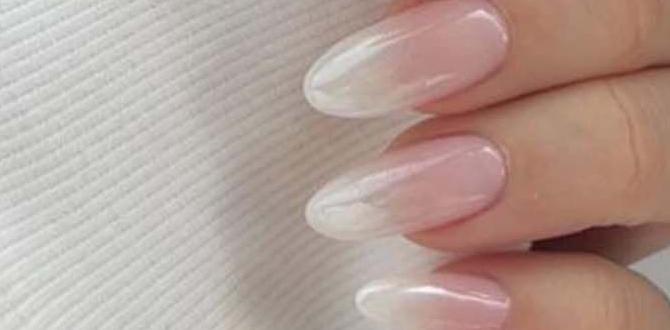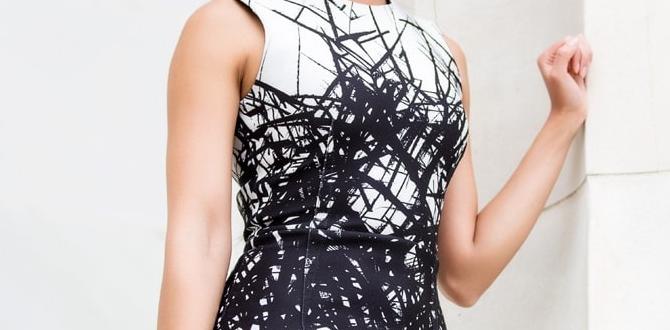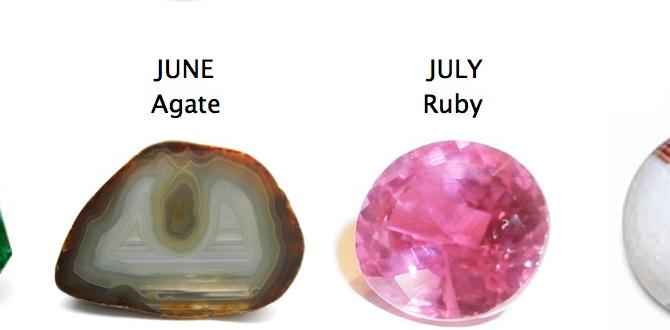Mastering tape nail art is easier than you think! This guide breaks down how to do nail art with tape using simple techniques and essential designs, perfect for beginners. Get ready to elevate your DIY manicures with clean lines and chic patterns in no time.
Ever admired those perfectly crisp lines and geometric patterns on manicures and thought, “I could never do that”? You’re not alone! Achieving sharp, professional-looking nail art can seem daunting. Many beginners struggle with freehand painting, leading to smudges and uneven designs. But what if I told you there’s a secret weapon? It’s probably already in your home or a quick drugstore find! We’re talking about good ol’ trusty tape. Yes, tape! It’s surprisingly effective at creating stunning, clean nail art designs that look like they came straight from a salon. Get ready to transform your nails into mini masterpieces with this easy-to-follow guide. We’ll cover everything you need to know to get started, from choosing the right tape to creating some of the most popular and essential tape nail art designs.
Why Tape is Your New Best Friend for Nail Art
For many of us, nail art has always felt out of reach. The idea of intricate patterns and flawless geometric shapes seems like a skill only a professional manicurist possesses. Then you try to do it yourself, and suddenly you’re dealing with shaky lines, messed-up polish, and a lot of frustration. It can be disheartening when your artistic vision ends up looking… well, not quite like the picture.
This is where tape swoops in to save the day! It acts as a stencil, guiding your polish and ensuring super clean edges. No more messy freehand work or wishing you had a steadier hand. Tape nail art is all about strategic placement and letting the tape do the heavy lifting. It’s incredibly beginner-friendly and unlocks a world of creative possibilities without needing advanced artistic talent. Think of it as your little shortcut to salon-worthy nails!
Essential Supplies for Tape Nail Art Success
Before we dive into the fun designs, let’s gather our tools. Having the right supplies makes the whole process smoother and ensures you get those amazing results. Don’t worry; most of these are everyday items!
Nail Polish: You’ll need a base coat, your desired colors (at least two for contrast), and a good top coat.
Tape: This is the star! We’ll talk more about types below, but painter’s tape or masking tape is your go-to.
Scissors or a Nail Art Cutter: For clean, precise cuts of the tape.
Tweezers (Optional but Recommended): To easily pick up and place small pieces of tape.
Nail File and Buffer: To prep your nails for a smooth canvas.
Cuticle Pusher/Orange Stick: To press down tape edges firmly.
Rubbing Alcohol or Nail Polish Remover: For cleaning nails and potentially cleaning up mistakes.
Choosing the Right Tape: What Works Best?
Not all tapes are created equal when it comes to nail art! The best tapes are those that are thin, flexible, and have a good balance of stickiness – strong enough to adhere but gentle enough not to peel off your base polish.
Painter’s Tape (Masking Tape): This is the absolute best for beginners. It’s readily available, inexpensive, and usually has a matte finish which helps with grip. It’s designed to be removed cleanly from most surfaces, which translates well to nail polish. Look for the blue or green varieties often recommended for delicate surfaces.
Washi Tape: This decorative tape comes in countless patterns and colors. While it can be used for nail art, its adhesive can sometimes be too sticky, potentially lifting your base nail polish. It’s also often thicker, which can make sharp edges a bit trickier. It’s better for creating patterns on top of a dry polish rather than using it as a stencil.
Regular Clear Tape: Avoid this! It’s often too sticky and can snag or lift your polish easily. It also doesn’t adhere as well to the curved surface of a nail.
Specialty Nail Art Tape: You can find thin, flexible tapes specifically designed for nail art online or in beauty supply stores. These are often self-adhesive strips that you can cut and place. They can be great for very fine lines but might be overkill when painter’s tape works so well for beginners.
Pro Tip: Always test your tape on a piece of paper with your base coat color first. Let it dry, apply a piece of tape, then peel it off. If it lifts the polish from the paper, it might be too aggressive for your nails!
Step-by-Step Guide: How to Do Nail Art With Tape
Ready to get creative? Follow these steps for flawless tape nail art every time. The key is patience and ensuring each layer of polish is completely dry before applying tape.
Step 1: Prep Your Nails
This is the foundation of any great manicure.
- Start with clean, dry nails. Remove any old polish.
- Shape your nails using a nail file.
- Gently push back your cuticles with an orange stick or cuticle pusher.
- Apply a thin layer of base coat. This protects your nails and helps polish adhere better. Let it dry completely.
Step 2: Apply Your Base Color(s)
Choose the colors you want to use for your design.
- Apply one or two thin, even coats of your first polish color. This will be the color showing through the tape for your design.
- Allow the polish to dry COMPLETELY. This is critical! If your base color is still wet or even slightly tacky, the tape will lift it, ruining your design. Use a quick-dry top coat as a bonus helper if you’re short on time.
Step 3: Cut and Place Your Tape
Now for the magic with the tape!
- Cut small pieces of painter’s tape to the desired shapes and sizes for your design. You can cut strips, squares, triangles, or even custom shapes. Using small scissors designed for crafts or a sharp craft knife on a cutting mat can give you cleaner edges.
- Carefully place the tape onto your completely dry base color. Press down firmly around the edges with your fingertip or an orange stick to ensure there are no gaps where polish can seep underneath.
- For intricate designs, you might need to overlap tape pieces or cut out specific areas.
Step 4: Apply Your Design Color(s)
It’s time to add the contrast!
- Apply your second (or third!) color of polish over the taped sections. Use thin, even coats. Two thin coats are usually better than one thick one for a smooth finish.
- Ensure the polish covers the entire area of the tape you want to color.
Step 5: The Grand Reveal: Removing the Tape
The most exciting part!
- While the top color polish is STILL wet (or at least not fully dry), carefully peel off the tape. Pull slowly and at an angle away from your design. Removing the tape while the polish is wet prevents it from drying and potentially cracking or pulling up with the tape.
- If any polish has seeped under the tape, you can try to carefully clean it up with a small brush dipped in nail polish remover before the polish dries completely.
Step 6: Seal the Deal
Protect your masterpiece!
- Let your design dry for a few minutes until it’s no longer tacky.
- Apply a generous layer of top coat. Make sure to cap the free edge of your nail by running the brush along the tip. This seals the design and adds shine, making your nail art last longer.
- Allow the top coat to dry completely before doing anything that might smudge your nails!
Essential Tape Nail Art Designs for Beginners
Now that you know the how, let’s explore some simple yet stunning designs you can create with tape. These are perfect for practicing and will impress everyone!
1. The Classic French Tip
This timeless look gets a modern update with tape.
- Apply a nude or sheer pink base coat and let it dry fully.
- Cut small crescent moon shapes or straight strips of tape.
- Place the tape along the edge of your nail where you want the white tip to start. For traditional French tips, this will be near the free edge. For reverse French tips, place it near the cuticle.
- Paint the exposed tip with white polish.
- While the white polish is still wet, carefully peel off the tape.
- Apply a top coat.
2. The Chic Half-Moon Mani
A sophisticated and modern design.
- Apply your base color (e.g., a deep red or navy) and let it dry completely.
- Cut small circular or semi-circular shapes from your tape. These should be just large enough to cover the area near your cuticle where you don’t want the second color.
- Carefully place the tape at the base of your nail, creating a curve along the cuticle line. Press down firmly.
- Paint the exposed nail bed with your second color (e.g., a metallic gold or nude).
- While the second color is wet, peel off the tape.
- Top coat and admire!
3. The Bold Geometric Stripe
Clean lines for a striking look.
- Apply your base color and let it dry thoroughly.
- Cut thin strips of tape. For thicker stripes, you can use wider tape pieces.
- Place your tape strips diagonally, horizontally, or vertically across the nail. Create as many lines as you like, leaving gaps between them for your second color.
- Paint over the tape and the exposed nail sections with your contrasting color.
- While the second color is wet, carefully peel off all the tape strips.
- Add a top coat once dry.
4. The Trendy Color Block
Simple yet impactful.
- Apply your first color and let it dry completely.
- Cut a piece of tape to cover about half of your nail, creating a straight line across it.
- Press the tape down firmly.
- Paint the uncovered half of your nail with a different color.
- While the second color is still wet, peel off the tape.
- Top coat and enjoy! You can repeat this on other nails with different color combinations.
5. The Negative Space V-Shape
A super chic and minimalist design.
- Apply a clear or sheer base coat and let it dry.
- Cut two pieces of tape to form a V-shape from the tip of your nail towards the cuticle, leaving the cuticle area and a V in the center uncovered.
- Apply your accent color over the taped sections.
- While the accent color is wet, carefully remove the tape.
- Apply your top coat over everything. The uncovered V-shape will remain clear, giving a stylish negative space effect.
Troubleshooting Common Tape Nail Art Issues
Even with tape, a few hiccups can occur when you’re starting out. Here’s how to fix them:
Polish Lifting with the Tape: This is the most common issue! It almost always means your base color wasn’t dry enough. Next time, wait longer or use a quick-dry spray. If it happens, you might be able to carefully dab a little polish on a fine brush and try to fix the line.
Polish Seeping Under the Tape: This means the tape edges weren’t pressed down firmly enough. Use an orange stick or cuticle pusher to really seal those edges before painting. If polish seeps, try to clean it up immediately with a small brush dipped in remover before it dries.
Jagged Lines: This can happen if the tape isn’t cut cleanly, or if it shifts slightly as you paint. Ensure you use sharp scissors for cutting tape and press it down firmly to prevent movement.
Tape Sticking Too Much: If your tape is lifting your base color when you apply it, try a different brand of painter’s tape or let your base color cure a little longer. Some people gently dab the sticky side of the tape on their hand a few times to reduce tackiness if it’s too aggressive.
For more in-depth nail care, understanding the science behind polish and how to keep your nails healthy is key. The National Library of Medicine offers great resources on general health, which contributes to nail strength.
Maintaining Your Tape Nail Art
Once your beautiful tape nail art is dry and sealed with a top coat, it’s ready to face the world! To help it last as long as possible:
Be Gentle: Avoid using your nails as tools – they aren’t!
Moisturize: Keep your hands and cuticles hydrated with cuticle oil and hand cream. Healthy cuticles help your polish adhere better.
Wear Gloves: When doing chores like washing dishes or cleaning, wear rubber gloves to protect your manicure from harsh chemicals and prolonged water exposure, which can cause polish to lift.
* Quick Fixes: If a tiny chip happens, you can sometimes carefully dab on a bit of matching polish and seal with a tiny bit of top coat to blend it in.
Frequently Asked Questions About Tape Nail Art
Q1: What’s the best type of tape to use for nail art?
A: For beginners, standard blue or green painter’s tape (masking tape) is the best choice. It’s easy to find, has the right amount of stickiness, and creates crisp lines.
Q2: How do I ensure the tape doesn’t lift my polish?
A: The most important step is making sure your base nail polish is completely dry before applying the tape. If it’s still tacky, the tape will likely lift it. You can also try pressing the tape down firmly around the edges with an orangewood stick.
Q3: Can I use nail polish remover to clean up mistakes?
A: Yes! It’s best to clean up any smudges or polish that seeps under the tape while the polish is still wet. Dip a very fine brush (like a liner nail art brush) into nail polish remover and carefully trace around the edges of your design.
Q4: What if I don’t have sharp scissors for cutting the tape?
A: While sharp scissors are ideal, if you don’t have them, try using a craft knife on a cutting mat for precision. If using regular scissors, try to make clean, deliberate cuts. For larger pieces, you can also carefully tear the tape, but this may result in less clean edges.
Q5: How long does tape nail art usually last?
A: With a good base coat and a strong top coat, tape nail art can last as long as any other well-applied manicure, typically 5-7 days, depending on how well you care for it and the health of your natural nails.
Q6: Can I use regular sticky tape (like Scotch tape)?
A: It’s generally not recommended. Regular clear tape tends to be too sticky, which can easily lift your base polish. It also doesn’t adhere as well to the curved nail surface, often leading to polish seeping underneath and less precise lines.
Q7: How can I achieve very fine lines with tape?
A: For very fine lines, you might need to invest in specialized nail art tape strips, which are very thin and flexible. Alternatively, you can try cutting very thin strips of painter’s tape yourself, but this requires very sharp scissors and a steady hand.
Conclusion: Your Nails, Your Canvas!
See? Doing nail art with tape isn’t some complicated secret reserved for professionals. It’s an accessible, fun, and incredibly effective way to achieve salon-quality designs right at home. From crisp French tips to bold geometric patterns, the possibilities are endless once you master this simple technique. Remember, practice makes perfect, so don’t be discouraged if your first attempt isn’t flawless. Each time you try, you’ll get a better feel for the tape, the polish, and precisely how to create those clean, stunning looks.
Embrace the creativity, experiment with colors, and most importantly, have fun with it! Your nails are a fantastic way to express your personal style, and tape nail art is your new secret weapon for making that style shine. So grab your polish, find some tape, and get ready to create some truly beautiful manicures. You’ve got this!





